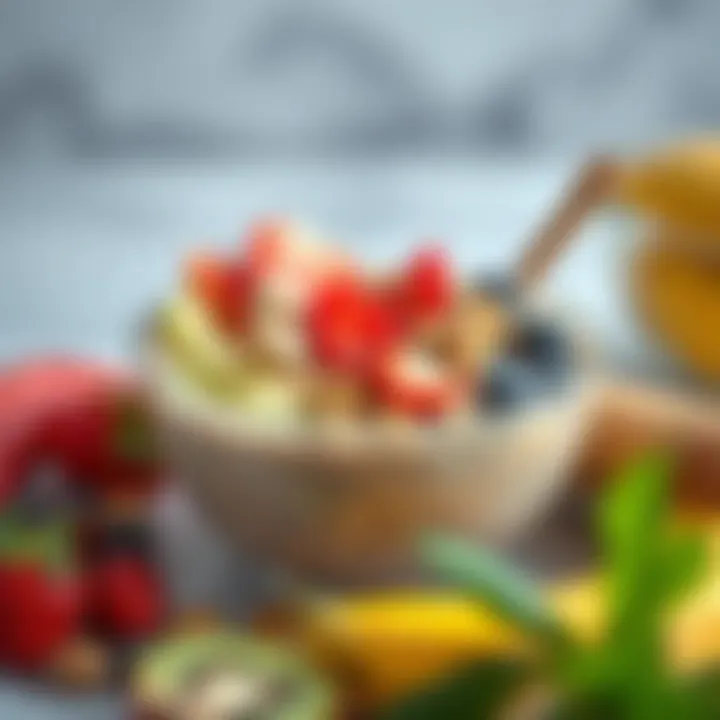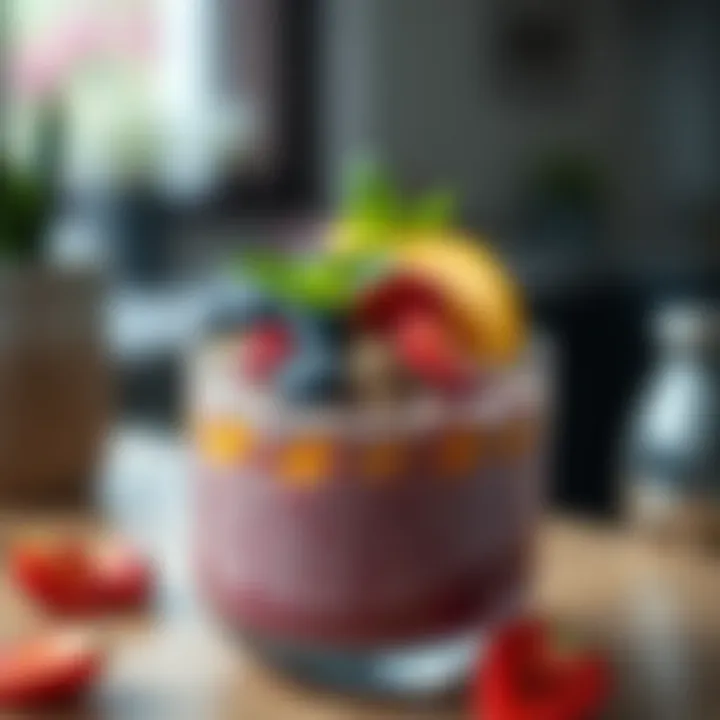Mastering Smoothie Bowls: A Complete Culinary Guide


Intro
Smoothie bowls have become quite the sensation in the culinary world. They’re not just a meal but an experience, celebrating both nutrition and aesthetics. Picture this: a vibrant blend of fruits and veggies, crafted into a creamy delight, and topped with everything from fresh fruits to crunchy granola. The appeal goes beyond taste; it caters to our visual senses and health-conscious tendencies, making it a favorite choice for breakfast or a midday snack.
In this guide, we’re going to delve into what makes a smoothie bowl truly perfect. We’ll explore ingredients that bring flavor and nourishment, as well as techniques to present your bowl like a chef would. By the end of it, you’ll have the know-how to create a delightful smoothie bowl that not only satisfies your palate but also dazzles your guests.
When crafting a smoothie bowl, understanding the elements at play is essential. Not every fruit blends smoothly, and not every topping enhances the dish. So let's do some digging into the art of this popular culinary creation.
Recipe Overview
Recipe Name
The Colorful Tropical Smoothie Bowl
Cuisine Type
Fusion (Breakfast/Dessert)
In essence, this dish draws from tropical inspirations while incorporating necessary nutrition, making it appealing to both epicureans and health devotees alike. What sets this voyage apart is how it's really about customizing to your taste and needs.
Ingredients
When it comes to creating a smoothie bowl, fresh ingredients are key to achieving that vibrant flavor and consistency. Here’s what you’ll need:
- 1 cup frozen mango chunks
- 1 banana, fresh or frozen
- 1/2 cup coconut milk (or any milk of choice)
- 1 tablespoon chia seeds
- Honey or maple syrup, to taste
Substitutions for Common Ingredients
If certain ingredients are unavailable, don’t worry! Here are some easy swaps:
- Instead of mango, use pineapple or peaches for a different fruity twist.
- Swap banana for avocado for creaminess without the sweetness.
- Coconut milk can be replaced with almond milk or oat milk, depending on dietary preferences.
Smoothie bowls aren't just about the blend; it's also about the toppings that aspiring gourmets throw on top. Let's jump into that part and hear why they can transform your bowl from standard to filled with pizazz.
Prelude to Smoothie Bowls
Smoothie bowls have recently burst onto the culinary scene, captivating the hearts—and taste buds—of food enthusiasts all over the world. Importantly, they aren't just a trendy dish; they embody the fusion of health and creativity, allowing for a meal that is as visually appealing as it is nutritious. In this section, we will explore the essence of smoothie bowls, delving into their components, roots in different cultures, and their myriad health benefits. Each aspect will heighten your understanding and appreciation for this delightful dish, making it more than just a simple blended fruit concoction.
Defining Smoothie Bowls
Smoothie bowls are essentially thick smoothies served in a bowl and enjoyed with a spoon. Unlike regular smoothies that might be consumed on the go, these bowls invite a slower, more introspective eating experience. They typically feature a base made from various fruits, vegetables, and sometimes even yogurt or nut milks, all blended to a creamy consistency. Unlike a thick shake, the goal here is to create a texture that holds toppings like fruits, nuts, seeds, and granola, providing a delightful crunch that balances the creaminess.
The magic lies in their versatility. You can flip this or that ingredient and tailor a recipe. Fancy a tropical twist? Why not toss in some mango and coconut? Prefer a berry blast? Strawberries and blueberries can work wonders too. In this way, smoothie bowls cater to individual tastes and dietary preferences.
Cultural Origins and Evolution
The roots of smoothie bowls can be traced back to various cultures that embrace fresh ingredients. The Brazilian açaí bowl gained popularity in the 1980s, featuring açaí berries blended to a velvety consistency and topped with fresh fruit and granola. Meanwhile, Hawaiian creations like the acai bowl, known locally as "açaí na tigela," highlight the use of locally sourced ingredients, showcasing the ethos of fresh, wholesome food.
Over the years, smoothie bowls have evolved. They’ve become a canvas for both traditional and avant-garde culinary artists. With their rise in popularity, adaptations have cropped up globally, blending various cultural influences. Things like matcha from Japan, turmeric from India, or spirulina from Africa find their way into bowls, making them not just a meal, but also a cultural statement about health, sustainability, and global cuisine.
Health Benefits of Smoothie Bowls
Looking for healthy options? Smoothie bowls deliver in spades. They can be a superb source of vitamins, minerals, fiber, and antioxidants, depending on the ingredients you choose. Generally, fruits and greens present in smoothie bowls are low in calories yet housed with essential nutrients. This means they can help support overall health while satisfying hunger pangs.
- Some notable health benefits include:
- Rich in Antioxidants: Ingredients like berries, spinach, and nuts act as powerful antioxidants, which help in fighting inflammation.
- Digestive Aid: High fiber content helps in maintaining digestive health and supporting regularity.
- Energy Boosting: Packed with natural sugars and healthy fats, smoothie bowls provide a quick energy boost, making them perfect for breakfast or post-workout fuel.
"Smoothie bowls are not just meals—they're an experience, an invitation to indulge in flavors while nourishing your body."
In essence, smoothie bowls are more than just a passing trend; they embody a unique blend of taste, health, and visual appeal that can elevate a simple meal into an exciting culinary endeavor. From the definition to the cultural evolution and health benefits, understanding these aspects sets the stage for perfecting your own smoothie bowl crafts.
Essential Ingredients
In crafting the perfect smoothie bowl, selecting the right ingredients is paramount. These components dictate not only the flavor but also the nutritional profile and overall satisfaction of your creation. It’s about finding harmonious combinations that excite the palate while delivering health benefits. Let’s explore the essential categories of ingredients that create a foundation for a delightful smoothie bowl experience.
Base Ingredients: Fruits and Vegetables
Fruits and vegetables are the stars of any smoothie bowl. They bring natural sweetness, vibrant colors, and a wealth of nutrients. When considering fruits, think beyond the usual suspects like bananas and strawberries. For instance, dragon fruit, with its striking pink hue, can become a visual centerpiece while also adding fiber. Similarly, incorporating leafy greens like spinach or kale can enhance the nutritional value without overpowering the flavor. Using a mix of both ensures a balance between taste and health benefits.
- Use seasonal produce whenever you can. Seasonal fruits often taste better and are usually more affordable. Whether it’s summer berries or autumnal pumpkin, let the seasons guide your choices.
- Experiment with textures. Not just any fruit will do; try blending in some coconut flesh or avocado for creamy goodness.
Liquid Components: Choosing the Right Base
Choosing the right liquid base can drastically alter your smoothie bowl's texture and flavor. While traditional choices include almond milk and coconut water, step out of the norm occasionally. Oat milk can lend a rich creaminess, particularly for those seeking a thicker bowl. Meanwhile, if you're in the mood for a refreshing punch, consider using freshly squeezed orange juice. It adds brightness and a citrusy zing that complements many fruit combinations.
- Consider the fat content in your liquid choice, as some bases, like coconut milk, can provide a creamy texture but adds higher calories. Balance it with lighter liquids if you're watching your caloric intake.
- Don’t shy away from herbal teas as a liquid base – for instance, hibiscus tea can provide a floral, slightly tart flavor that pairs wonderfully with berries.
Protein Options: Enhancing Nutritional Value


Adding a source of protein transforms your smoothy bowl from a snack to a meal. Greek yogurt is an excellent option, as it adds creaminess and a probiotic boost as well. Nut butters like almond or cashew can enhance both taste and protein content while also making the bowl more filling. In case you're leaning towards plant-based options, consider pea protein powder or adding hemp seeds; these not only boost protein but also provide essential fatty acids.
- Serving sizes matter; incorporating too much protein can alter the balance of flavors. Aim for a moderate scoop that complements, rather than overwhelms, the primary fruity base.
- Mix and match by using different sources of protein. This diversity can keep the palate excited across different smoothie bowl creations.
Sweeteners: Natural vs. Artificial
When it comes to sweeteners, the debate between natural and artificial can seem convoluted. However, many enthusiasts prefer to steer clear of artificial options due to their health implications. Honey, maple syrup, or agave nectar are often favored, but there are also natural alternatives like dates or stevia to consider.
- Taste testing is key. Each sweetener carries its own unique flavor. Dates, for example, lend a caramel-like richness that could complement cacao-based bowls.
- Be judicious with measurements. Just because a recipe calls for a certain amount doesn’t mean you can't adjust to suit your taste. Start small, and add more if needed.
"The best ingredients yield the best outcomes. Nail the essentials, and the rest will fall into place."
To dive deeper into ingredient sourcing or nutrition tips, consider checking resources such as Wikipedia or Britannica.
With a solid understanding of the essentials, you’re ready to embark on your journey toward the perfect smoothie bowl.
Techniques for Crafting Smoothie Bowls
Creating a smoothie bowl is more than just tossing fruits and vegetables into a blender; it’s an art. This section focuses on techniques that elevate your smoothie bowl game, ensuring that every bowl not only tastes divine but also bears an aesthetic appeal. Understanding the methods of blending, achieving the perfect consistency, and mastering the art of layering can completely transform your culinary creation.
Correct Blending Methods
Blending is where the magic starts. Selecting the right technique for blending can greatly influence the texture and flavor of your bowl. Here are some pointers to keep in mind:
- Layering Ingredients: Put soft items like bananas and avocados at the bottom of the blender so they can easily blend. Add frozen fruits afterward to help create that thick texture.
- Pulse Function: Use your blender’s pulse setting initially to chop larger items. This method prevents the blades from getting stuck and ensures a more even mixture.
- Blending Time: Don’t skimp on blending time. A well-blended mixture leads to a smoother and creamier base, vital for that gorgeous bowl.
If you make one mistake here, it's blending for not long enough. The outcome will be chunky instead of creamy, which isn’t ideal. Look for a silky texture where nothing feels out of place.
Achieving the Right Consistency
Consistency is king when crafting smoothie bowls. The texture should be thick enough to hold toppings without being so stiff that it feels like a workout to get a spoonful. Here’s how to nail it:
- Adjust Liquid Levels: Start with a modest amount of liquid; you can always add more if it’s too thick, but if it's too runny, you're basically making a smoothie, not a bowl.
- Frozen Ingredients: Use frozen fruits as a primary base to contribute to a thick, spoonable texture. They chill and thicken your blend naturally.
- Experiment: Don’t be afraid to adjust with different ingredients. For instance, adding a splash of coconut yogurt can add creaminess without diluting the thickness.
Ultimately, achieving the right consistency can make or break your smoothie bowl. The optimal blend should behave more like a soft serve than a drink.
Layering and Textural Balance
Layering is pertinent both for flavor and visual presentation. A well-crafted smoothie bowl should offer a delightful variety of textures with every bite. Here’s how to find that sweet balance:
- Combine Textures: Aim for a mix of creamy, crunchy, and chewy. If your base is all smooth, pair it with crunchy toppings like granola or nuts for contrast.
- Strategic Topping Placement: Spread your toppings evenly across the bowl—this not only makes your bowl eye-catching, but it also ensures that every spoonful offers a uniform mix of flavors.
- Visual Appeal: Aesthetically, think about colors and shapes. Using an array of toppings—from fresh fruit slices to seeds—adds a dynamic quality that invites the eater to dive in.
"In food, as in life, balance is the key to all things. A smoothie bowl that misses textural balance is just a smoothie you’re trying to spoon instead of sip."
Mastering these techniques ensures that your smoothie bowl is not just another meal but a culinary experience that delights the senses. You'll serve up a bowl that is both pleasing to the palate and the eyes, encouraging others to savor and enjoy each bite.
Flavor Combinations to Consider
Understanding flavor combinations in a smoothie bowl isn't just about throwing ingredients together; it's about creating a harmonious blend that excites the palate while delighting the senses. The right combinations can enhance nutritional benefits and elevate the overall enjoyment of this dish. The beauty of smoothie bowls lies in their versatility—users can mix and match various ingredients to suit their preferences, dietary needs, or even the season. When we talk about flavor, it encompasses not just taste but also aroma and visual appeal, making it essential to strike a balance between all these elements.
Fruity Fusion Ideas
Fruits serve as the star players in smoothie bowls, offering vibrant flavors and a plethora of nutrients. Combining fruits can yield thrilling results. For instance, blending ripe bananas with tangy pineapple creates a creamy and sweet concoction that tantalizes taste buds. Another great fusion is the blend of berries—strawberries, blueberries, and raspberries—which not only brings a beautiful hue to your bowl but also packs a punch of antioxidants.
- Banana and Pineapple: Smooth and tropical, perfect for a refreshing experience.
- Mixed Berries: A classic combo, each bite reflects sweetness and slight tartness.
- Mango and Coconut: Evokes a tropical paradise in every spoon.
Playing with textures is crucial too. Adding a handful of spinach or kale can give your smoothie a nutrient boost while introducing a subtle earthiness that balances out sweeter fruits. This fusion of flavors allows one to explore boundaries and land on exciting combinations that can be both nourishing and delightful.
Incorporating Superfoods
Superfoods can transform a simple smoothie bowl into a nutrient powerhouse without much fuss. Ingredients like chia seeds, hemp hearts, or spirulina bring nutritional benefits and depth of flavor. For example, mixing a spoonful of spirulina into a banana and spinach smoothie creates a vibrant green bowl that is rich in protein and antioxidants.
- Chia Seeds: Add texture and are packed with omega-3 fatty acids.
- Hemp Hearts: Provide a nutty flavor along with complete protein.
- Acai Powder: Offers a berry-like flavor while delivering tons of antioxidants.
These superfoods can often go unnoticed, but their impact is significant. A sprinkle here or there can elevate the whole experience. Plus, they allow for a bit of creativity—trying different combinations and discovering which superfoods pair well with your selected fruits can be a fun culinary adventure.
Balancing Sweet and Savory
Achieving a balance between sweet and savory in your smoothie bowl can really make it a standout dish. While fruits add a natural sweetness, incorporating savory elements can create contrast and complexity. Imagine adding a sprinkle of sea salt or a dash of nutmeg to your mango smoothie—this kind of unexpected touch can awaken the flavors in a way that's positively thrilling.
Think about how adding a dollop of nut butter can introduce a savory richness that complements the sweetness of bananas or dates. Alternatively, a few slices of avocado can not only enhance the creaminess but also provide healthy fats and a subtle savory note.
- Peanut Butter and Banana: A classic combo that is both sweet and nutty.
- Avocado with Berries: Adds creaminess while balancing acidity.
- Cinnamon with Apples: This duo offers a cozy warmth and an element of surprise.
The interplay of sweet and savory elements opens the door to endless possibilities. Remember, the key is to taste as you go, allowing your palate to guide you to the perfect balance. The journey is as important as the destination when crafting your masterpiece.
"Creating the perfect smoothie bowl is not just about following a recipe. It's about experimenting and finding what pleases your taste buds."
By exploring these aspects of flavor combinations, you can elevate your smoothie bowl game. Whether you’re preparing for breakfast or a refreshing afternoon snack, the choices you make can transform your experience from mundane to extraordinary.
Garnishing Techniques


Garnishing techniques play a critical role in adding that extra flair to smoothie bowls. They’re not merely decorative; they enhance flavor and texture, turning a simple dish into a work of art. Effective garnishing can entice not just the palate but also the eyes, creating an inviting meal. This is particularly significant in today’s social media world, where presentation can make or break the appeal of a dish. Let’s dive into the essential aspects of garnishing, focusing on the importance of choosing appropriate toppings, adhering to smart presentation principles, and considering seasonal suggestions that elevate your creations.
Choosing the Right Toppings
Selecting the right toppings can transform your smoothie bowl from bland to grand. They should complement the base ingredients and enhance overall flavor. Here are some topping ideas:
- Nuts: Almonds, walnuts, and pistachios not only add crunch but also healthy fats.
- Seeds: Chia seeds or hemp hearts can amplify the nutritional benefits with omega-3 fatty acids.
- Fruits: Fresh berries, bananas, and unique options like dragon fruit can burst with flavor. Consider using fruits that align seasonally for the best taste and freshness.
- Coconut Flakes: These lend a tropical twist that works wonderfully in many blends.
- Granola: Choose a low-sugar variety for added texture but not overwhelming sweetness.
When picking toppings, balance is key. Too many can overwhelm a dish while too few might render it visually uninspired. The goal is to create an appealing contrast with colors and textures that encourage the beholder to dig in.
Presentation Principles
Presentation is an art that marries science with creativity. While the flavors can speak for themselves, a pleasing aesthetic attracts attention and enhances the overall experience. Here are several principles to keep in mind when presenting your smoothie bowl:
- Color Harmony: Aim for a vibrant mix of hues. Use complementary colors, like green spinach with bright berries and yellow mango.
- Layering: Don’t just throw everything on top. Layer your fruits and toppings so that each spoonful offers a surprise. For example, a layer of granola beneath a mix of vibrant fruits looks inviting.
- Symmetry vs. Asymmetry: Decide on a layout style. Symmetrical designs can evoke precision, while asymmetrical patterns often add an element of surprise and excitement to the dish.
- Uniform Sizes: Chopping fruits into similar sizes helps maintain overall balance. Attention to detail often separates an average bowl from an exceptional one.
"A well-presented dish elicits a different response than one that is overlooked. Presentation is not merely about looks—it's about initiating an experience."
Seasonal Garnish Suggestions
Using seasonal ingredients can not only enhance flavor but also elevate the overall experience of your smoothie bowl. Each season brings a unique array of fruits and vegetables that can be harvested at their peak. Consider these memorable seasonal garnishes:
- Spring: Fresh mint leaves, edible flowers, or citrus slices. These add brightness and a refreshing feel to spring-themed bowls.
- Summer: Local berries, peaches, and melons shine in summer months. A sprinkle of basil can give an unexpected twist.
- Fall: Pumpkin seeds, spiced apples, or even a drizzle of maple syrup provide warmth and comfort, perfect for chilly days.
- Winter: Citrus fruits like tangerines or pomegranates brighten up dreary winter months while offering a burst of flavor.
Incorporating seasonal garnishes can prompt a connection with nature and encourage culinary creativity. By drawing from the seasons, you make your bowls not only more delicious but also more authentic.
Smoothie Bowl Variations
Variety is the spice of life, and when it comes to smoothie bowls, this couldn’t be more true. Exploring different smoothie bowl variations allows not only for a broader palate but also caters to varying dietary needs. This section illuminates the multifaceted world of smoothie bowls, highlighting options that can please vegans, fitness enthusiasts, or those simply looking to reduce their carbohydrate intake. The beauty of these bowls is that you can easily transform a standard recipe into something fresh and exciting, ensuring you never hit a culinary dead end.
Vegan Smoothie Bowl Options
For plant-based eaters, smoothie bowls can offer a delightful and nourishing meal. Vegan options abound, utilizing fruits, vegetables, nuts, seeds, and legumes. With clever choices, you can create a bowl that is bursting with flavor and nutrition without using any animal products.
Consider the following ideas for your vegan smoothie bowls:
- Base: Start with a creamy blend of bananas, spinach, and a splash of coconut milk to get a beautiful green color. This mix not only offers a creamy texture but also packs a punch of vitamins and minerals.
- Superfoods: Incorporate ingredients like chia seeds or spirulina for added nutritional benefits.
- Toppings: Fresh fruits like berries, kiwi slices, and a sprinkle of coconut flakes can elevate the bowl, making it visually appealing and satisfying.
Vegan bowls are versatile and can be tailored to specific tastes, such as a tropical bowl featuring mango and coconut or a berry-packed rendition brimming with antioxidants.
Protein-Packed Alternatives
For those looking to amp up their protein intake, protein-packed smoothie bowls are the way to go. Many of us understand that protein is key for muscle repair and overall wellbeing, and integrating it into our smoothie bowls is a smart move.
Here’s how to create these hearty bowls:
- Incorporate Protein-Powders: A scoop of your favorite protein powder, whether it be whey, pea, or hemp, can significantly boost the protein content.
- Nut Butters: Add almond or peanut butter for a satisfying taste while also increasing the protein level. Not only do they provide a creamy texture but they also enhance the flavor.
- Greek Yogurt: If nondairy isn’t a must, consider adding Greek yogurt. It’s a fantastic source of protein and benefits gut health, making your bowl more balanced.
Top these bowls with crunchy granola, nuts, and seeds for added texture. You’ll find these protein-rich options can keep you feeling full and energized well into the day.
Low-Carb and Keto-Friendly Bowls
For anyone pursuing a low-carbohydrate diet, keto-friendly smoothie bowls can be a great option. Crafting these bowls requires a thoughtful approach to ingredients to ensure they remain both flavorful and in line with dietary goals.
- Bases: Instead of traditional fruits, think about using avocado or unsweetened almond butter as a base. Both provide healthy fats without the carbs, creating a creamy blend that's hard to resist.
- Low-Carb Fruits: Incorporate berries, like raspberries and strawberries, which are lower in sugar, to add a touch of sweetness.
- Heavy Cream or Coconut Milk: Adding these options increases fat content, helping to keep in line with keto principles.
"A well-crafted low-carb smoothie bowl not only satisfies hunger but also keeps blood sugar levels stable."
When garnished with nuts, seeds, or sugar-free chocolate shavings, these bowls will satisfy your sweet tooth while adhering to a low-carb lifestyle.
Exploring these variations enriches your smoothie bowl experience, ensuring there’s always a new flavor, texture, or nutrient boost waiting to be discovered!
Smoothie Bowls for Different Occasions
In the realm of culinary creativity, smoothie bowls stand as a vibrant canvas, ready to be transformed depending on the mood or occasion. From a light breakfast that kickstarts your day to a decadent dessert that satisfies your sweet tooth, these bowls can morph into something suitable for virtually any setting.
Different occasions call for varying ingredients, flavors, and toppings. This section will explore how to tailor smoothie bowls to specific moments in your life, each with its unique flair and nutritional benefits. Let's dive into the delightful world of smoothie bowls tailored for breakfast, post-workout recovery, and dessert.
Breakfast Smoothie Bowls
Breakfast is often touted as the most important meal of the day. Nothing energizes the morning quite like a refreshing breakfast smoothie bowl. When crafting a bowl meant for the dawn hours, focus on nutrient-rich ingredients that awaken both the body and palate.
Key Elements to Consider:
- Base Ingredients: Start with a thick blend of bananas, spinach, or oats. These elements not only provide substantial nutrition but also form a satisfying foundation.
- Protein: Adding Greek yogurt or a scoop of protein powder can help maintain energy levels throughout the morning.
- Flavor Boost: Incorporate nut butters like almond or peanut to enhance both texture and taste.
Recipe Idea:
- 1 banana
- 1 cup spinach
- 1/2 cup almond milk
- 2 tablespoons almond butter
"Starting the day off right with a nutrient-packed smoothie bowl can have a lasting impact on your overall energy and mood."


Post-Workout Recovery Bowls
After a sweat session, your body craves nourishment for muscle recovery and energy replenishment. A post-workout smoothie bowl should be rich in protein and antioxidants to support physical recovery.
Best Ingredients:
- Protein-Rich Bases: Use protein powder, or opt for Greek yogurt or cottage cheese as your base. These options can help repair muscles and reduce fatigue.
- Fruits for Recovery: Berries, especially blueberries, are great for reducing inflammation, while bananas provide quick-digesting carbs.
- Healthy Fats: Consider adding avocado or chia seeds for healthy fats that balance the macronutrients.
Recipe Idea:
- 1 cup frozen mixed berries
- 1 cup Greek yogurt
- 1 banana
- 1 tablespoon chia seeds
Dessert Smoothie Bowls
Who says dessert can’t be healthy? A smoothie bowl can easily transform into a guilt-free delight that satisfies your sweet cravings without compromising health goals. These bowls can be indulgent yet nutritious, making them an ideal end to any meal.
What to Include:
- Sweet Bases: Use thickened coconut milk, or a banana-based blend topped with cacao powder for a rich chocolatey flavor.
- Toppings: Fresh fruit slices, granola, or even a sprinkle of nuts can add texture and appeal.
- Natural Sweeteners: To enhance sweetness, consider dates or a drizzle of honey.
Recipe Idea:
- 1 frozen banana
- 1/2 cup coconut milk
- 2 tablespoons cacao powder
- Toppings: sliced strawberries, almond slices, and a drizzle of agave syrup
Sourcing Quality Ingredients
An essential step in crafting an exceptional smoothie bowl is sourcing quality ingredients. The quality of each ingredient can significantly impact the final product’s flavor and nutritional profile. Select ingredients with care, and you’ll not only enhance the taste but also support health benefits.
Local vs. Organic Produce
When it comes to choosing between local and organic produce, both have their merits. Local produce often offers fresher and more vibrant fruits and vegetables. These items are typically evaluated and picked at peak ripeness, meaning they maintain higher levels of flavor and nutrients. Buying from local farmers’ markets can also contribute to the community and ensure you’re getting the freshest produce available.
On the other hand, organic produce is cultivated without synthetic fertilizers or pesticides, which can lead to safer, healthier food options over pesticides that may linger on conventionally grown items. The absence of harmful chemicals also aligns with sustainable practices, promoting ecological balance. While both choices boast advantages, it may be beneficial to consider a blend of both to achieve the optimal balance between freshness and health consciousness.
"Quality over quantity. The foundation of a magnificent smoothie bowl starts with quality ingredients."
High-Quality Protein Additions
Incorporating high-quality protein into your smoothie bowl is indispensable for enhancing its nutritional value. Protein not only fosters muscle repair and balance but also keeps you feeling full longer. When selecting protein sources, lean towards options that are wholesome and minimally processed.
For instance, Greek yogurt stands out as a perfect addition, packed with protein and probiotics, which support gut health. Alternatively, plant-based sources like hemp seeds or chia seeds are excellent for those following a vegan or vegetarian lifestyle. These seeds come loaded with fiber and healthy fats, aiding in overall well-being.
Another option worth considering is protein powder. Look for brands that boast high purity levels and minimal additives. Whey, pea, or brown rice protein can each offer unique benefits depending on dietary preferences. Always scrutinize the ingredient label to ensure you're opting for products that enhance your smoothie bowl rather than complicate it.
In short, whether it’s by selecting top-notch local produce or introducing wholesome proteins, sourcing quality ingredients lays the groundwork for smoothie bowls that not only satisfy your taste buds but also nourish your body.
Common Mistakes to Avoid
Creating a smoothie bowl may seem like a simple task, yet it's all too easy to fall into traps that can compromise both flavor and presentation. Understanding these pitfalls helps you elevate your smoothie bowl game. Mistakes can lead to dishes that are either too bland, overly rich, or simply unpleasing to the eye. Focusing on precision when mixing and garnishing is crucial in perfecting this dish. Avoiding common errors not only improves the overall dining experience but also ensures that your creation is as nutritious as it is delicious.
Overdosing Ingredients
One of the most frequent blunders in smoothie bowl preparation is overloading on ingredients. It’s tempting to pile in all your favorite fruits, greens, and toppings. However, less can indeed be more. Here’s why:
- Balance Matters: The flavor can easily become muddled. If the sweet notes from banana overpower the earthy tones of spinach, the bowl loses its complexity. Each ingredient should shine through without overshadowing the rest.
- Nutritional Overload: While you might think that more ingredients equal more nutrients, it can backfire. Too much fruit may increase sugar content, making it less healthy than anticipated. A smoothie bowl should be a nourishing meal, not a sugar bomb.
- Texture Troubles: When you pack in too many ingredients, achieving a smooth consistency can be a struggle. It may end up too thick to eat easily, or too soupy if you add excess liquids trying to blend everything together.
To avoid such pitfalls, consider limiting your base to just two or three key ingredients that complement each other well. This approach not only preserves the intended texture but also enhances the flavor, creating a harmonious blend.
Neglecting Aesthetic Considerations
Presentation can make or break the appeal of your smoothie bowl. The phrase "you eat with your eyes first" couldn't be more apt here. A neglected bowl, regardless of its taste, will fail to entice. Think about these aspects:
- Visual Balance: A good smoothie bowl should have a variety of colors and textures. If everything blends into a murky brown, it’s far from appetizing. Use vibrant fruits, seeds, and nuts to create contrast and interest.
- Layering: Utilizing different layers of ingredients not only adds visual appeal but also creates textured experiences. Don’t just dump everything on top. Try placing denser powders or chunky toppings at the bottom of the bowl.
- Garnishing: Simple garnishes can amplify both the aesthetic and flavor. Using fresh mint leaves or edible flowers not only makes for eye-catching decoration but can also add a refreshing taste.
By paying attention to these aesthetic details, you turn a straightforward dish into a culinary art piece.
Remember, a well-crafted smoothie bowl is not just about the flavors; it's an experience that should engage all the senses.
Each choice you make, from ingredients to presentation, contributes to the final dish. When you combine careful ingredient selection with thoughtful aesthetics, you not only avoid common mistakes but also create a smoothie bowl that impresses on every level.
Ending: The Art of Smoothie Bowls
Crafting a smoothie bowl is not just about tossing ingredients into a blender; it’s a culinary journey that marries flavor, nutrition, and aesthetics. This guide has offered a comprehensive insight into various aspects of crafting the perfect smoothie bowl, shedding light on the importance of ingredient selection, blending techniques, and presentation. The beauty of smoothie bowls is that they cater to a myriad of dietary preferences while being flexible enough to allow for personal creativity.
Reflecting on Flavor and Nutrition
Flavor serves as the heart of any food experience, and smoothie bowls are no exception. Each layer of fruit, nut, or grain serves not only to tantalize the taste buds but also to provide significant nutritional value. Consider the natural sweetness of ripe bananas paired with the tangy notes of acai berries; together they form a flavor profile that's both refreshing and energizing. Nutrition, in this context, isn’t just a secondary benefit; it’s woven into the fabric of the bowl's design. Rich in vitamins, minerals, and antioxidants, smoothie bowls can improve overall health, boosting immunity and providing a quick energy source.
In reflecting on these elements, we can appreciate how ingredient choices can reflect personal and cultural backgrounds. This personalization can transform an ordinary breakfast into a dynamic expression of one’s culinary identity, showcasing not just what we eat, but who we are.
Encouraging Culinary Exploration
Encouraging culinary exploration is what makes the adventure of smoothie bowls so enticing. There are no hard and fast rules when it comes to creating these delightful dishes. Experimentation with flavors—such as adding cardamom to a tropical mix or a sprinkle of turmeric for added health benefits—can lead to exciting outcomes.
The diverse variety of ingredients available allows for endless combinations and variations to suit every season, mood, or occasion. Don’t shy away from trying unexpected elements like spirulina or matcha, which can elevate the bowl’s nutritional profile while introducing a splash of color. Moreover, engaging in this kind of culinary experimentation can turn kitchen time into a therapeutic escape, allowing individuals to connect with their food in a deeper way.
In closing, mastering the art of smoothie bowls opens the door to a world of flavors and health benefits. Encourage yourself to play and discover what pleases your palate while nourishing your body. With the right approach, every smoothie bowl can be a fascinating creation, drawing admiration and satisfaction in equal measure.















